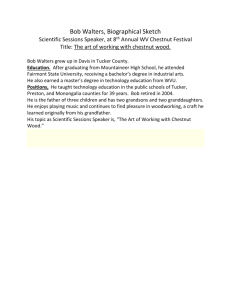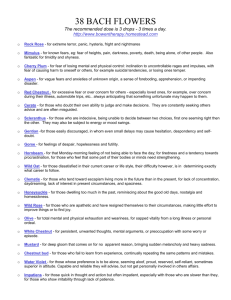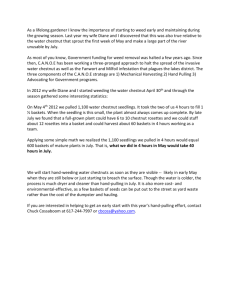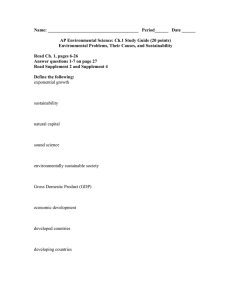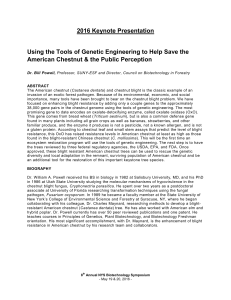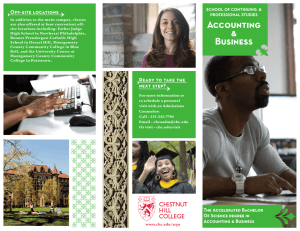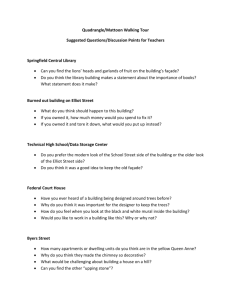ANNUAL REPORT: June 1, 2010 – May 31, 2011
advertisement
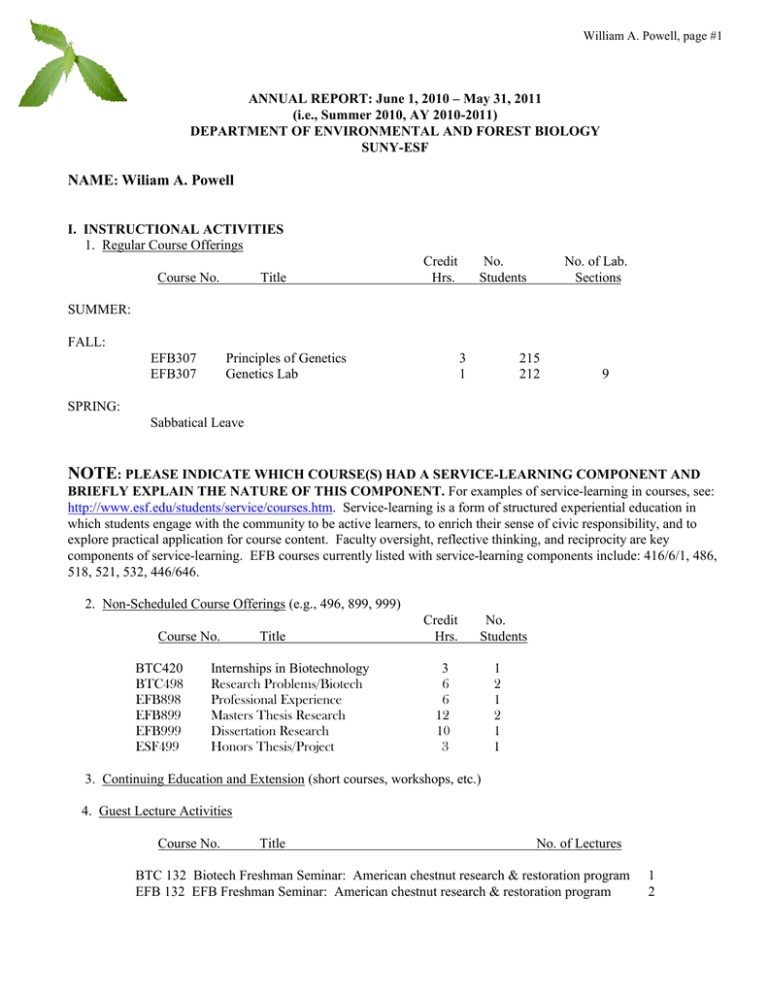
William A. Powell, page #1 ANNUAL REPORT: June 1, 2010 – May 31, 2011 (i.e., Summer 2010, AY 2010-2011) DEPARTMENT OF ENVIRONMENTAL AND FOREST BIOLOGY SUNY-ESF NAME: Wiliam A. Powell I. INSTRUCTIONAL ACTIVITIES 1. Regular Course Offerings Course No. Title Credit Hrs. No. Students No. of Lab. Sections SUMMER: FALL: EFB307 EFB307 Principles of Genetics Genetics Lab 3 1 215 212 9 SPRING: Sabbatical Leave NOTE: PLEASE INDICATE WHICH COURSE(S) HAD A SERVICE-LEARNING COMPONENT AND BRIEFLY EXPLAIN THE NATURE OF THIS COMPONENT. For examples of service-learning in courses, see: http://www.esf.edu/students/service/courses.htm. Service-learning is a form of structured experiential education in which students engage with the community to be active learners, to enrich their sense of civic responsibility, and to explore practical application for course content. Faculty oversight, reflective thinking, and reciprocity are key components of service-learning. EFB courses currently listed with service-learning components include: 416/6/1, 486, 518, 521, 532, 446/646. 2. Non-Scheduled Course Offerings (e.g., 496, 899, 999) Course No. BTC420 BTC498 EFB898 EFB899 EFB999 ESF499 Title Internships in Biotechnology Research Problems/Biotech Professional Experience Masters Thesis Research Dissertation Research Honors Thesis/Project Credit Hrs. No. Students 3 6 6 12 10 3 1 2 1 2 1 1 3. Continuing Education and Extension (short courses, workshops, etc.) 4. Guest Lecture Activities Course No. Title No. of Lectures BTC 132 Biotech Freshman Seminar: American chestnut research & restoration program EFB 132 EFB Freshman Seminar: American chestnut research & restoration program 1 2 William A. Powell, page #2 II. STUDENT ADVISING A. Number of undergraduates for whom you are the student’s official advisor __17___ and unofficial advisor __53_ (as coordinator of Biotechnology major)___ B. Graduate Students: (Name, degree sought, starting date, month & year; if a degree was completed, please give date and full citation for the thesis or dissertation). MAJOR PROFESSOR 1. Amelia Bo Zhang, PhD, started August 2006 2. Katherine D’Amico, MS, started August 2008 3. Kristen Russell Steward, MPS, started August 2010 CO-MAJOR PROFESSOR 1. Allison Oakes, MS, (with Dr. Maynard), started May 2009 MEMBER, STEERING COMMITTEE (other than those listed above) 1. Christina Quinn, MS, started F2007 2. Arnold Salazar, Ph.D., started 2007? 3. Marian Orlousky, MPS, started 2009 4. Jeremy Dicenza, MS, started 2011 CHAIRMAN OR READER ON THESIS EXAMS, ETC. 1. Som Mukherjee (Dissertation Examiner – in progress) III. RESEARCH COMPLETED OR UNDERWAY A. Departmental Research (unsupported, boot-legged; title - % time spent) Continuing research to develop DED and Elm Yellows resistant American elm. Currently unfunded. Approximately 3% of time. B. 1. Grant-supported Research (source, subject, amount - total award and current year, award period starting and ending dates; list graduate research assistants supported by each grant) William A. Powell, page #3 Three new grants received this year totaling $105,635 in addition to the eight continuing grants previously awarded. 1. New. Forest Health Initiative. Supplemental funding to develop an early blight resistance screening assay for American chestnut. $105,000 (7/1/10 – 6/30/12). PI with Dr. Maynard as Co-PI. 2. New. ArborGen LLC. Transformation of American chestnut with genes encoding transcription factors. $20,000 (1/1/11-12/31/12) PI with Dr. Maynard as Co-PI. Another year of 10 years of support beginning in 2002 totaling $500,000. 3. New. The American Chestnut Foundation. Travel grant to China to collect DNA and RNA samples from Asian chestnut species. $16,600. PI with graduate student Amelia Bo Zhang as co-PI. 4. Forest Health Initiative. First and second-generation transgenic American chestnut trees. $900,000 (8/1/09 – 7/31/12). PI with Dr. Maynard as Co-PI. Currently supporting 2 MS students. This is our part of a multiinstitutional grant totaling $5.2 million. Opportunity to renew an additional three years if progress is sufficient. 5. Forest Health Initiative. Supplemental funding to examine early flowering genes in transgenic American chestnut. $83,000 (6/1/10 – 5/31/12). PI with Dr. Maynard as Co-PI. 6. Consortium on Plant Biotechnology Research (CPBR). Collaborative research: Developing blight resistance in transgenic American chestnut for agroforestry and restoration. $67,000 (5/1/10-4/30/11) PI with Dr. Maynard as co-PI. Will support one Ph.D. student 7. The New York Chapter of The American Chestnut Foundation. Supplemental grant for technician support for Chestnut research. $20,000 (1/1/10-12/31/11). PI with Dr. Maynard as co-PI. 8. Vetlesen Foundation. Equipment grant for woody tissue grinder. $14,000 (6/1/10-12/31/10). PI with Kathleen Baier as co-PI. 9. USDA-Biotechnology Risk Assessment Grant program (BRAG), Evaluating Environmental Impacts Of Transgenic American Chestnut Trees To Chestnut Trees Produced By Conventional Breeding. $380,000 (10/1/08-9/30/11). PI with co-PIs, Dr. Maynard, Dr. Horton, Dr. Parry, and Dr. Leopold. Supported one technician this year but will support 5 summer graduate stipends in the last two years.. 10. The New York Chapter of The American Chestnut Foundation. Testing Transgenic Events for Gene Copy Number, Gene Expression, and Blight Resistance. $100,000 (5/08-6/11). PI with Dr. Maynard as co-PI. Supports summer graduate student in my lab and a technician. 11. The New York Chapter of The American Chestnut Foundation. Regenerating Transformation Events into Whole Plants and Expansion of Field Trials. $300,000 (5/08-6/11). Co-PI with Dr. Maynard, PI. This is in addition to the grant above. It will support a technician in Dr. Maynard’s lab, a summer graduate student in my lab, and hourly undergraduate students for field research. 2. Research Proposals pending (include information as in B.1., above). 1. USDA-Biotechnology Risk Assessment Grant program (BRAG), Evaluating Environmental Impacts Of Maturing Transgenic American Chestnut Trees Relative To Chestnut Trees Produced By Conventional Breeding. $500,000 (10/1/11-9/30/14). PI with co-PIs, Dr. Maynard, Dr. Leopold, Dr. Parry, Dr Fernando, Dr. Briggs, and Dr. Nowak. William A. Powell, page #4 2. Pennsylvania State University/Horticultural Research Institute (HRI), Development of Elm Trees Resistant to Elm Yellows. $15,026. Co-PI with Dr. Maynard and Cristina Rosa (PSU) 3. Research Proposals submitted, but rejected (include information as in B.1, above) IV. PUBLICATIONS (Full bibliographic citation, i.e., do not use "with Jones," or "Jones, et al."; please list only publications published, in press, or actually submitted during this reporting period --- do not list manuscripts in preparation). A. Refereed Publications H. Liang, P.A. Kumar, V. Nain, W.A. Powell, J.E. Carlson (2010) Selection and Screening Strategies. In: C. Kole, C.H. Michler, A.G. Abbott and T.C. Hall (eds) Development and Deployment of Transgenic Plants. SpringerVerlag – Berlin, Heidelberg, New York, Tokyo, Vol. 1, pp. 85-143 (note: We have a backlog of about 7 manuscripts in various stages of preparation. So next year should look better.) B. Non-refereed Publications Article on transgenic American chestnut trees in the Bur and the Journal of The American Chestnut Foundation (in press). Phone interview for article in Science: Sara Reardon. 2011. EPA Proposal Would Exempt Some GMOs From Registry. Science 332:652 C. Papers Presented at Science Meetings (give title, date, occasion, and location) (Note that every presentation required modifications to incorporate the most recent results, adjust to the particular audience, and to fit the presentation format given. These are not just repeats of the same talk.) Restoration of the American chestnut. 5/18/11. Cary Institute of Ecosystem Studies, Millbrook, NY Update on American chestnut research. The American Chestnut Science Cabinet planning meeting. 5/4/11. Penn State, State College, PA American Chestnut Research and Restoration Project. 4/29/11. Monsanto, St Louis, MO American Chestnut Research and Restoration Project. 4/29/11. Danforth Plant Science Center, St Louis, MO American Chestnut Research and Restoration Project. 4/28/11. Invited speaker. Missouri University of Science and Technology, MO Update on American chestnut research. 4/15-4/16/11. The American Chestnut Foundation’s annual Board and Cabinet meetings, Abingdon, VA Update on American chestnut research. 4/7 – 4/8/11. Forest Health Initiative, Science Advisory Committee’s reverse site visit, Raleigh, NC William A. Powell, page #5 Developing Blight Resistance in Transgenic American Chestnut for Agroforestry and Restoration. 3/1-3/2/11. Consortium for Plant Biotechnology Research (CPBR) symposium, Washington, DC American Chestnut Research and Restoration Project. 1/28/11. Invited speaker: Clemson University Seminar, Clemson, SC Update on American chestnut research. 10/29/10, Annual meeting of the New York chapter of The American Chestnut Foundation, Syracuse, NY Progress on transgenic chestnut research. 9/16 – 9/18/10, Annual NE1033 chestnut researchers meeting, Cataloochee Ranch in Maggie Valley, NC D. Public Service Presentations (lectures, seminars, etc. to and for the public; give group or occasion, date(s), and attendance) Restoration of the American chestnut: Old problem, New solutions. 4/30/11. Missouri Botanical Gardens, St Louis, MO (approximately 9 attended) Restoration of the American chestnut: Old problem, New solutions. 3/15/11. Council on Environmental Health meeting. Layfayette, NY (approximately 15 attended) Restoration of the American chestnut: Old problem, New solutions. 2/17/11. Fayetteville Free Library, Fayetteville, NY (approximately 30 attended) V. PUBLIC SERVICE A. Funded Service (include consulting activities) 1. Government Agencies (Federal, State, Local): 2. Industrial and Commercial Groups, etc. B. Unfunded Service to Governmental Agencies, Public Interest Groups, etc. Held the Annual meeting of the NT chapter of The American chestnut Foundation on the ESF campus. Gave talks, and lab, greenhouse, and field tours. Advisor to the NY chapter of The American Chestnut Foundation Science advisory board member of the national American Chestnut Foundation ESF Alumni Reunion Weekend tours of labs and greenhouse VI. PROFESSIONAL DEVELOPMENT A. Professional Honors and Awards (for teaching, research, outreach, etc.) William A. Powell, page #6 B. 1. Activities in Professional Organizations (offices held, service as chairman, member, participant or consultant) 2. Professional Society Membership American Phytopathological Society American Association for the Advancement of Science 3. Other Professional Activities a. Editorial activity Journal (s) Other (books, symposia, etc.) b. Reviewer Journal(s) Tree Physiology Tree Genetics and Genomes Plant Cell Reports American Journal of Enology and Viticulture Agency Consortium on Plant Biotechnology Research USDA SBIR Program National Institute of Food and Agriculture (NIFA) Responsibility No. of manuscripts 1 1 1 1 No. of proposals 1 1 1 Other c. Participation (workshops, symposia, etc.) Name of workshop, etc. Date Place C. Further Education/Re-training Undertaken, Leaves, Workshops, etc. D. Foreign Travel (Where, When, Purpose) VII. ADMINISTRATIVE AND SERVICE RESPONSIBILITIES (include committee participation) A. Department-level Faculty representative on ARB building Committee Coordinator for the undergraduate Biotechnology major B. College-level Director of the Council on Biotechnology in Forestry William A. Powell, page #7 IBC (Institutional Biosafety Committee) member C. University-wide, including Research Foundation D. Foreign Travel (Where, When, Purpose) Making preparations and obtaining funding for a two week trip to various locations in China to collect RNA and DNA samples from native chestnut species. The trip is scheduled for the first two weeks of Sep. 2011. VIII. SUMMARY OF SIGNIFICANT ACTIVITIES AND ACCOMPLISHMENTS DURING THIS REPORTING PERIOD, ESPECIALLY THOSE MOST NOTEWORTHY AND RELATIVE TO THE COLLEGE’S AND DEPARTMENT’S MISSION. One paragraph on each of the following would be most helpful: this past year, what have you done for our students, department/college, and self professionally? NOTE: The information in this section (along with the supporting specific information elsewhere in this report) should be your strongest case for being considered for a discretionary raise, which I’ll continue to award based on your contributions to the department and college this reporting period. Highlights of what I have done for our students: This year I implemented a new technology, the i-clicker, into my large genetics course. This has worked very well and has increased overall student participation during the lectures by giving all the students the opportunity to answer questions at the same time. The student evaluations were very positive. I highly recommend it for all our large classes. In addition, I continue to provide research opportunities and support for my four gradate students and the many undergraduate students who complete projects in my lab. Highlights of what I have done for our department and college: For our department, I continued serving as one of the faculty representatives for the new ARB building even during my sabbatical leave. With respect to the lab design, I have tried to be as flexible as possible with the architects without jeopardizing our ability to perform “wet lab” types of research. I have also agreed to produce chestnut trees and elms for the landscape around the building. Our research to develop a resistant American chestnut tree puts ESF in the forefront of tree restoration. This is unique because restoration of a tree species has never done before. We have had our first preliminary lab tests that show enhancement in blight resistance in our transgenic American chestnut. This will be confirmed this summer when we inoculate our field grown trees and it will let us know the level of resistance achieved. If confirmed, we can begin the process for deregulation with the USDA, EPA, and FDA. If these first trees are not up to par, we have many more coming through the development pipeline. Highlights of what I have done for myself professionally: I am completing a sabbatical that incorporated many small trips and presentations. The trips were very valuable for getting the word out about our chestnut research as well as for getting advice about techniques (both lab and field), regulatory issues, and feedback on public opinion. All this will help advance the restoration of the American chestnut tree. IX. A. FUTURE PLANS, AMBITIONS, AND POTENTIAL CONTRIBUTIONS FOR YOUR OWN PROFESSIONAL DEVELOPMENT AND THE ENHANCEMENT OF THE PROGRAM IN ENVIRONMENTAL AND FOREST BIOLOGY (brief summary) William A. Powell, page #8 B. PROJECTED ACTIVITIES FOR NEXT YEAR 1. Summer 2011 a. Course(s) to be offered I will continue to offer research projects at the graduate and undergraduate levels. b. Proposed research activity I will continue mainly with the chestnut research but also finish some of our elm field trials. c. University, professional society, and public service Same high standards as before. 2. Fall Semester 2011 a. Course(s) to be offered Principles of Genetics & Genetics Lab Freshman Seminar for Biotech majors. Guest lectures as before. b. Proposed research activity Same high standards as before focusing on chestnut and elm research. c. University, Professional society, and public service Same high standards as before. 3. Spring Semester 2012 – a. Course(s) to be offered Plant Biotechnology Research Design and Professional Development b. Proposed research activity I will continue all my research c. University, professional society, and public service as before
